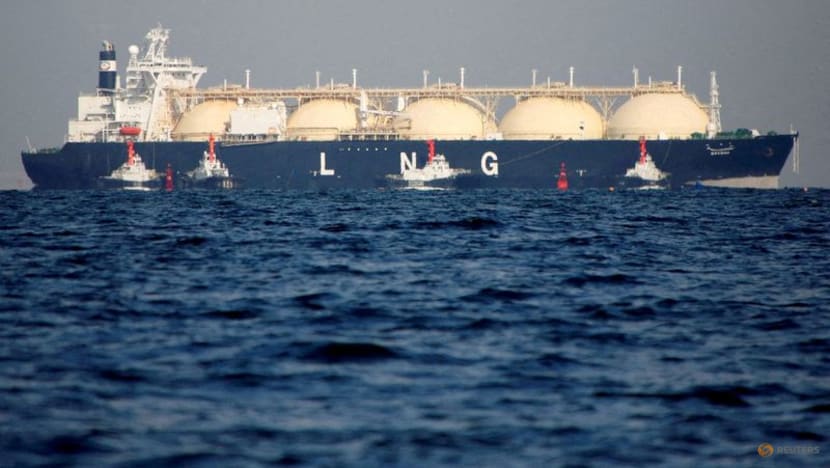What LNG can and can’t do to replace Europe’s imports of Russian gas

A liquefied natural gas (LNG) tanker is tugged towards a thermal power station in Futtsu, east of Tokyo, Japan, Nov 13, 2017. (File photo: Reuters/Issei Kato)
Provoked by Russia’s invasion of Ukraine and its threat to cut off natural gas exports to Europe, the European Union says it intends to wean itself off Russian supplies entirely within a few years.
It’s a tall order, as Russian gas covers about a third of the continent’s consumption.
A crucial part of the plan is to greatly increase purchases of liquefied natural gas from non-Russian producers.
The extent to which global LNG supply can expand is constrained, however, setting Europe up for a battle for supply with Asian buyers.
That risks precipitating higher prices and energy shortages that could compel Asian countries to shift to dirtier fuels, compromising climate goals.
WHAT IS LNG?
The places where natural gas is found are often hundreds or thousands of miles away from where it’s used in power plants, factories, refineries and homes.
It can be moved relatively cheaply by land through pipelines, but only to fixed points.
Over the past six decades, a multi-billion-dollar industry has developed to freeze the gas to minus 162 degrees Celsius, at which point it changes into a liquid that can be loaded aboard refrigerated ships and sent across the globe.
Related:
WHY CAN’T LNG SUPPLY EASILY EXPAND?
Although a new natural gas well can be brought into production within weeks, it takes several years to obtain the permits, land contracts, and billions of dollars in financing necessary to construct a new plant to liquefy natural gas or an import terminal to receive it and convert LNG back to gas.
Building the required, specialised tankers also takes time and a huge investment.
So, for the immediate future, the world is limited to the existing LNG infrastructure. It consists of about four dozen LNG plants and 150 import terminals scattered around the globe, with some 600 tankers that can ferry cargoes in between, according to the International Gas Union.
WHAT’S AVAILABLE FOR EUROPE TO BUY?
Global LNG production - led by the US, Qatar, and Australia - is expected to reach 452.8 million tons (410.77 tonnes) by the end of the year, figures from Bloomberg Intelligence show.
Based on weekly traffic, roughly 70 per cent of cargoes on the water are reserved for customers holding long-term contracts while the remaining 30 per cent is being sold on the global spot market.
That means roughly 136 million tons of LNG this year will go to the highest bidder. In theory, that’s enough to cover Europe’s imports from Russia of around 160 billion cubic meters of natural gas, the equivalent of 118 million tons of LNG.
Related:
DOES EUROPE HAVE SUFFICIENT INFRASTRUCTURE TO RECEIVE THAT MUCH LNG?
At the moment, European nations are importing around 80 million tons of LNG per year.
At maximum capacity, figures from Bloomberg Intelligence show, they can import a combined 145 million tons, which means there’s spare capacity for about 65 million additional tons. So, even at maximum capacity, LNG imports would only cover half of Russian pipeline gas.
Also, European nations would need to reconfigure pipeline routes and build interconnections to move the gas from coastal import terminals to demand centres in the interior of the continent.
HOW MIGHT INCREASED PURCHASES BY EUROPE AFFECT OTHER IMPORTERS?
In the immediate aftermath of the Ukraine invasion, a confluence of factors eased demand among typically big LNG importers, freeing cargoes to head to Europe.
North Asia has experienced a mild winter and rains in Brazil improved the supply of hydroelectric power.
In the second quarter, however, a tug-of-war over cargoes is expected to heat up, forcing Europe to outbid competitors to secure supplies.
Already the war in Ukraine has sent LNG spot prices soaring, and the trend is expected to continue. Poorer countries, such as India and Pakistan, that are less able to pay lofty prices could face energy shortages that strain their economies.
Higher prices and potential shortages mean utilities in countries such as Japan, South Korea and Pakistan - which rely on imported gas to generate a large chunk of electricity - could shift to more carbon-intensive alternatives like coal and fuel oil, intensifying pollution and compromising efforts to contain global warming.














